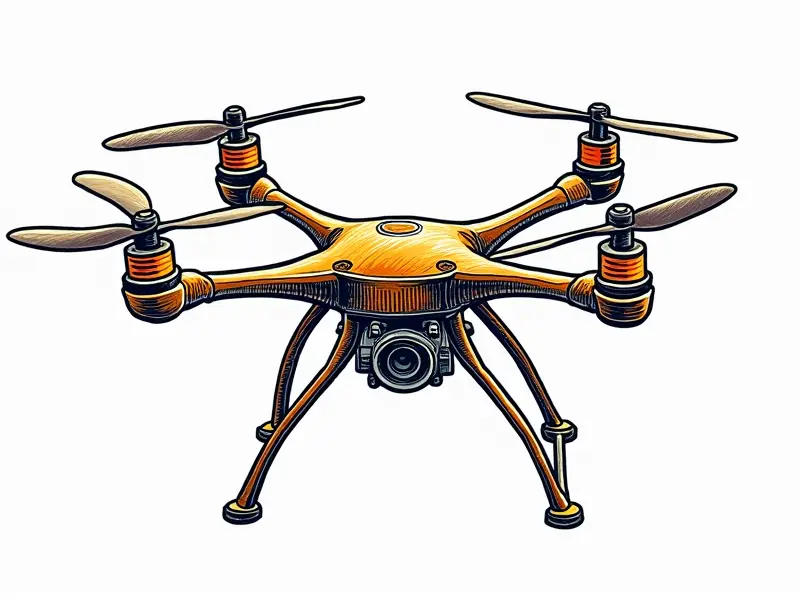How does a quadcopter fly?

A quadcopter, also known as a multirotor or drone, is an aerial vehicle that has gained immense popularity in recent years due to its versatility and agility. This article delves into the intricate details of how a quadcopter achieves flight, focusing on the science behind its lift, thrust, stability, control systems, and maneuverability.
The Science Behind Quadcopter Flight
Quadcopters operate based on fundamental principles of aerodynamics and physics. The primary components that enable a quadcopter to fly are its rotors (propellers) and the electronic speed controllers (ESCs). These elements work in tandem to generate lift, thrust, and control over the drone's orientation.
Understanding Quadcopter Lift & Thrust
Lift is generated by the rotation of the propellers. As each propeller spins, it creates a low-pressure area above its surface and a high-pressure area below, causing air to flow upwards. This upward airflow counteracts gravity, allowing the quadcopter to ascend.
Propeller Dynamics
The thrust produced by the propellers is directly proportional to their rotational speed. Faster rotation results in greater lift force, enabling the drone to climb higher or hover at a specific altitude.
Mastering Quadcopter Propeller Dynamics
A quadcopter typically has four rotors arranged symmetrically around its center of gravity. Two propellers rotate clockwise (CW), while the other two rotate counterclockwise (CCW). This configuration ensures that the rotational forces cancel each other out, maintaining stability.
Propeller Interactions
The interaction between CW and CCW propellers is crucial for balancing torque. By adjusting the speed of individual motors, a quadcopter can tilt in any direction without spinning uncontrollably.
Secrets of Quadcopter Stability in Flight
Maintaining stability during flight involves several factors such as weight distribution, aerodynamic design, and control algorithms. The center of gravity (CG) must be precisely balanced to prevent unwanted rotations or tilts.
Inertial Measurement Units (IMUs)
Quadcopters use IMUs to measure acceleration, angular velocity, and orientation in real-time. This data is essential for maintaining stability and correcting any deviations from the desired flight path.
Exploring Quadcopter Control Systems Basics
The control system of a quadcopter comprises hardware components like ESCs, motors, and sensors, as well as software algorithms that process sensor data to adjust motor speeds accordingly. This closed-loop feedback mechanism ensures precise control over the drone's movements.
Flight Controllers
A flight controller acts as the brain of a quadcopter, coordinating all onboard systems to achieve stable flight. It processes input from various sensors and adjusts motor outputs in real-time to maintain balance and orientation.
Why Quadcopters Are So Agile in the Sky
The agility of quadcopters stems from their ability to independently control each rotor's speed, allowing for rapid changes in direction and altitude. This capability makes them highly maneuverable compared to traditional aircraft.
Multiaxis Control
By varying the speed of individual propellers, a quadcopter can tilt its body in any direction instantly. This multiaxis control is what enables complex aerial maneuvers like flips and rolls.
The Physics of Quadcopter Hovering Techniques
To hover steadily, a quadcopter must generate enough lift to counteract the force of gravity while maintaining stability. This requires precise balancing of thrust from all four propellers.
Thrust Vectoring
Hovering involves adjusting the thrust vector so that it is directly opposite to the gravitational pull. By fine-tuning motor speeds, a quadcopter can maintain a constant altitude without drifting.
Inside a Quadcopter's Flight Autopilot System
The autopilot system in a quadcopter automates many flight tasks such as maintaining altitude, heading, and position. It uses advanced algorithms to interpret sensor data and make real-time adjustments.
Navigational Algorithms
Autopilots employ sophisticated navigation algorithms that utilize GPS signals for precise positioning and orientation control. This enables autonomous flights with minimal human intervention.
Mastering Quadcopter Aerial Maneuvers
Achieving complex aerial maneuvers requires a deep understanding of how to manipulate individual propeller speeds. By varying the thrust on different rotors, pilots can execute intricate flight patterns and stunts.
Maneuver Techniques
- Rolls: Tilting the quadcopter sideways by increasing speed on one side of the drone while decreasing it on the opposite side.
- Pitches: Tipping forward or backward to change direction, achieved by adjusting thrust levels between front and back propellers.
- Yaws: Rotating around its vertical axis, accomplished by increasing speed on one pair of rotors while decreasing it on the other.
How Propellers Power Quadcopter Flight
The power generated by propellers is crucial for all aspects of quadcopter flight. Efficient propeller design and motor performance are key factors in achieving optimal lift, thrust, and maneuverability.
Propeller Efficiency
A well-designed propeller maximizes the conversion of electrical energy into aerodynamic force. Factors such as blade pitch, diameter, and material play significant roles in determining overall efficiency.
Demystifying Quadcopter Hover Techniques
Hovering is one of the most challenging aspects of quadcopter flight due to the need for precise control over all four rotors simultaneously. Advanced stabilization techniques are employed to achieve smooth and stable hovering.
Stabilization Methods
- PID Control: Proportional-Integral-Derivative (PID) controllers adjust motor speeds based on error signals from sensors, ensuring rapid correction of any deviations.
- Fuzzy Logic: Fuzzy logic systems use a set of rules to approximate human decision-making processes, providing more intuitive control over complex maneuvers.
Conclusion
The science behind quadcopter flight is fascinating and intricate. From the fundamental principles of lift and thrust generation to advanced stabilization techniques and autopilot systems, every aspect contributes to the remarkable agility and versatility of these aerial vehicles. Understanding how a quadcopter flies not only enhances appreciation for this technology but also opens up new possibilities in fields ranging from entertainment to scientific research.

